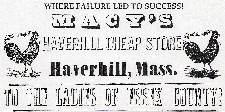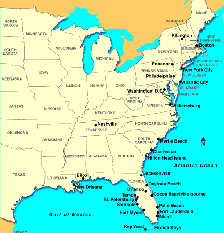
On July 4, 1854, Macy set the stage for a national tradition when he organized a parade, led by a band, to march past his shop. The day was extremely hot, and only one hundred, or so, people came out to see the parade, but it eventually became an annual event, and was destined to be called the “Macy Day Parade”.
Macey founds his empire:
HAVERHILL MASSECHUSETTS USA
A Life Feature by Ian Hornsey
Did you know that Haverhill Suffolk
is not the only town by that name.
There is another Haverhill in USA in the
state of Massachusetts (MA).
In this second part of his history of
the town Ian Hornsey explores the town’s development
into a major East Coast city which now has three times the population
of our own town (60,000 people).
In the course of his investigations Ian
discovers the founder of the famous Macys store in New York, Louis B.
Mayer the Hollywood mogul who founded the Metro Goldwyn Mayer studios
and even Graham Alexander Bell the inventor of the
Telephone. He also tells us of the life
of John Whittier who was one of the foremost
leaders in the abolition of Slavery . All this proves that Haverhill MA
has not wasted the inheritance given to
it by it founding fathers so long ago.
Haverhill MA was founded
in the 17th century by settlers from England and it was named after one
of its founding fathers who was born in Haverhill Suffolk.
In our previous article we discovered
how the settlers struggled against the elements to make the town a success.
Now we follow the town’s progress as it develops into a modern day
city.
Throughout the 17th and 18th centuries the town of Haverhill steadily grew and by the 19th century it had established itself with a regionally important cattle market.Ever entrepreneurial, the businessmen of the town took advantage of the cattle market by producing as many different articles as they could from the beasts. Products included salt beef; combs made from horns; and other leather products such as gloves, saddles, harnesses and shoes.
It was the shoe industry that first made Haverhill's mark on the world.
In 1811, 20,000 pairs of shoes were being
produced. By 1830, the number had grown to 1,500,000. In 1890,
over 11,000 people were employed in the shoe industry and that number
continued to grow well into the early
1900's. Haverhill became a world leader in the shoe industry and was called
the "Queen Shoe City of the World"
The town became famous for shoe designers, as well as manufacturers. At
the industry's peak, Haverhill had over
200 shoe establishments and a fine array of support businesses.
In the words of one eminent historian: “The Merrimack River served as
a key mode of transportation from prehistoric times into the early 19th
century. Once the railroad opened in 1839 there was a shift in transportation
which also fostered the shift in the economy to the shoe industry”. Shoe-making
began to decline after World War I, and suffered even more during the
Depression and after WW II. It plays hardly any part at all in the Haverhill
economy today, although the continued presence of many 19th
and early-20th
century factories along the river’s edge attest to the glories of past
times.



Rowland Hussey Macy (1822-
Macy, who was born into a Quaker seafaring family on nearby
Nantucket Island, was seemingly introduced to Haverhill by a shoe manufacturer,
Caleb Hunking, who had taught on Nantucket, and who owned the four-storey
building in which Macy commenced trading. One of Rowland’s ancestors,
Thomas, was one of the nine original purchasers of the island who paid
“thirty pounds and two beaver hats” for Nantucket, which is now a well-
Macy ran his Haverhill shop for five years, during which time he established
a reputation for good value and fair dealing; his shop being particularly
busy on market days.
He was noted for his flamboyance, and newspaper advertisements
were always addressed to “The Ladies of Essex County”, and accompanied
by a picture of a rooster – the latter being seen as an implication that
the store always had something to ‘crow about’. Macy's policy
for his store was:
"My goods are bought for cash, and will be sold for the same, at
a small advance".
In 1856, Macy faced bankruptcy and was forced to close the Haverhill shop. He relocated to New York City, where he opened a similar dry goods shop, under the name of ‘R.H.Macy & Company’ on the corner of 14th Street and 6th Avenue. On his first day (28th October 1858) of trading in the New York shop, Macy took $11.06, but in his first full year of trading sales totalled $90,000.
Always the innovator, Macy was responsible for several ‘firsts’ that revolutionised the retail industry. Macy's was the first retailer to promote a woman, Margaret Getchell, to an executive position, thereby making business history.
The store also pioneered such revolutionary business practices as the one-price system, in which the same item was sold to every customer at one price, and quoting specific prices for goods in newspaper advertising.
Known for its creative merchandising, Macy's was the first to introduce such products as the tea bag, and coloured bath towels, and it was the first retailer to hold a New York City liquor licence.
Part 1 The Early Years part 1 Part 2 The Early Years part 2 Part 4 Haverhill Massechusetts 20th Century
Part 5 The Modernisation of Haverhill
Part 6 Haverhill
MA and the Abolition of Slavery
